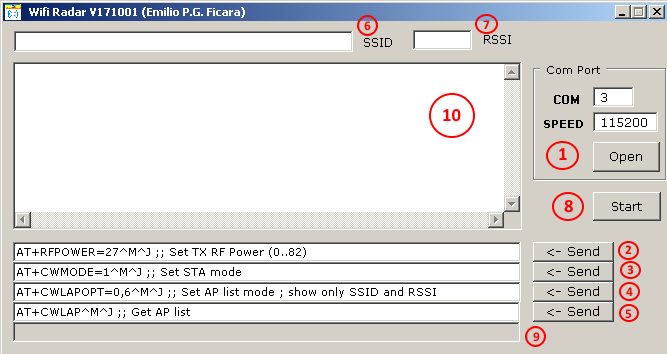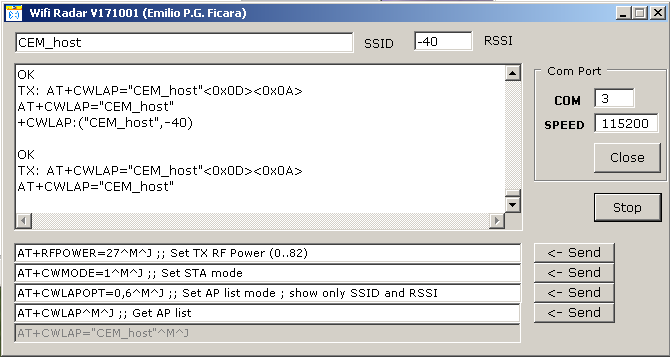ESP-01: Alternative use of RSSI
Normally, we use the ESP-01 wifi module to make devices that connect to the Internet; we transmit or receive information, basically to make sensors or actuators. There are tons of applications out there, some well documented and original, others copies of copies of copies (recursive). On the one hand, there are beginners with a "shameful" preparation who pass themselves off as "specialists", well aware of the fact that there will always be someone on the Internet who understands less than them 🙂, while others are definitely "good and prepared” and reading what they propose is really interesting, even for an “insider”.
In recent years, products such as Arduino, ESP8266 and Raspberry PI have “revitalized” a hobby sector that was practically dead, with absolutely positive consequences for the entire electronics and information technology sectors. As already mentioned, however, there is also the negative factor of so many people without talent who "smear the walls", but it is an acceptable counterpart, just to see again the enthusiasm for self-construction, as it was at the (beautiful ) times of the "paper magazines".
To do some tests concerning an idea that came to my mind, I developed a little program that uses one of the “features” of the ESP-01 module in the firmware version with AT protocol. The purpose of this program is to make “beeps” when the RSSI (Received Signal Strength Indicator) measurement of a given Access Point falls below a set threshold. I decided to publish the entire project folder, containing both the executable on the path /release/Radar.exe , and the source file in FreeBASIC (with FireFly Visual Designer) on the path /forms/Form1.frm , so whoever wants to, can modify / improve the software as wanted. Let's see the screen of the program just launched:

Let's go by points: (1) it is the button to open the serial communication port towards the ESP-01 module. I used the same circuit presented some time ago on my website at this link. First, we will press Open and if everything goes well, the serial port will be opened and the label on the button will change to Close . Immediately afterwards we will press in order the buttons referred to with (2) , (3) , (4) and (5). These are used to send a series of AT commands to the ESP-01 wifi module. First of all, set the transmission power to about one third of the maximum possible (27 on a range from 0 to 82); then you choose to operate as STA (station); then you are asked to use, in the CWLAP (List Access Points) command only the parameters relating to SSID and RSSI (value 6 sets bits 1 and 2, which are in fact relative to the two fields indicated). Finally, the complete list of Access Points "visible" from the module is requested. Below is an example of everything that appears in window (10) by carrying out the operations listed in order:
>Open
TX: AT+RFPOWER=27<0x0D><0x0A>
AT+RFPOWER=27
OK
TX: AT+CWMODE=1<0x0D><0x0A>
AT+CWMODE=1
OK
TX: AT+CWLAPOPT=0,6<0x0D><0x0A>
AT+CWLAPOPT=0,6
OK
TX: AT+CWLAP<0x0D><0x0A>
AT+CWLAP
+CWLAP:("MW40Wind_xxxx",-58)
+CWLAP:("DIRECT-Bh-BRAVIA",-86)
+CWLAP:("NETGEAR26",-93)
+CWLAP:("CEM_host",-36)
OK
Once the list of APs is displayed, we can make a "copy" of the one we want to use and then paste it in the field referred to by the number (6) . We will therefore also take note of the RSSI value relating to the same AP and we will write it in the field referred to by the number (7) . At this point we can finally press the Start button (8) and the program will start to send a series of commands AT + CWLAP = ”APcopied”, which we can see in field (9) and then it will check the answers given by the module. If the received RSSI value is lower (they are negative numbers!) than what we have programmed in field (7) , then a “beep” will be heard. Let's see a screen of the running program:

Of course, the RSSI value is influenced by various factors and is not constant, but it remains within a certain range. Note that the closer the number gets to zero, the stronger the signal is ! If it drops to the level of -100, it is absent. With a certain approximation and with a little sensitivity 🙂 we will be able to use the Esp-01 module as a presence sensor. In fact, if someone places near the module, or rather, on the ideal line that joins the module to the Access Point, the signal will decrease (it will be absorbed / reflected by the individual) and the computer will beep! The same will happen if we take the computer (assuming it is a laptop!) and move away from the Access Point. It should be noted that we don’t make a connection to the AP, but we just read the received signal strength. So, we have two immediate uses for this “toy”: a presence sensor and a distance alarm. Of course, it can all be carried over to a very small microcontroller to make the work more interesting. Unfortunately, the use of the AT commands makes it a bit slow: typically a “beep” every two seconds, but working directly on the ESP8266 chip (with the right tools) you can do much more! Under the disclaimer, you will find the FBgui_Radar folder zipped with password. If you don't have Freebasic and Firefly for FreeBasic installed, you can easily find them searching on the Internet. It’s easy and it’s free, like most of the best things in the life...
Disclaimer of liability. The program or software described, freely downloadable from the site, is to be considered a free "demo" and therefore the author Emilio PG Ficara will not provide any support, nor will he assume any responsibility for any problem, damage or consequence that may arise in the download or running the application.
By download from the "files" section, you implicitly declare that you have read and understood the disclaimer and to accept it.
Always check the checksum of the files you download! In this case it must be sha1: 4b0690ed545f734023c7627a69c1ac5e5211ea7c
If it is different, the file is corrupt or not the original one, so don't unpack it and throw it away! If everything is ok, you can unpack it (use password: eficara).
Note: you can also use the executable on a USB memory stick, as it does not need installation.
 Emilio P.G. Ficara
Emilio P.G. Ficara